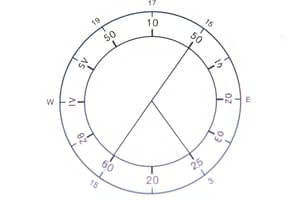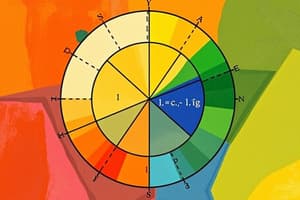Podcast
Questions and Answers
In a unit circle, how does the value of $\theta$ affect the coordinates (x, y) on the circle's perimeter?
In a unit circle, how does the value of $\theta$ affect the coordinates (x, y) on the circle's perimeter?
- As $\theta$ increases, x and y remain constant.
- As $\theta$ decreases, x increases and y decreases linearly.
- As $\theta$ changes, both x and y values change between -1 and 1. (correct)
- The values of x and y are independent of $\theta$.
Given the definitions of cosine and sine functions in a unit circle, how are $cos(\theta)$ and $sin(\theta)$ related to the coordinates (x, y) of a point on the circle?
Given the definitions of cosine and sine functions in a unit circle, how are $cos(\theta)$ and $sin(\theta)$ related to the coordinates (x, y) of a point on the circle?
- $cos(\theta) = x + y$ and $sin(\theta) = x - y$
- $cos(\theta) = \frac{x}{y}$ and $sin(\theta) = \frac{y}{x}$
- $cos(\theta) = y$ and $sin(\theta) = x$
- $cos(\theta) = x$ and $sin(\theta) = y$ (correct)
If $sin(\alpha + \beta) = sin(\alpha)cos(\beta) + cos(\alpha)sin(\beta)$ and $cos(\alpha + \beta) = cos(\alpha)cos(\beta) - sin(\alpha)sin(\beta)$, which of the following expressions correctly represents $sin(2\alpha)$?
If $sin(\alpha + \beta) = sin(\alpha)cos(\beta) + cos(\alpha)sin(\beta)$ and $cos(\alpha + \beta) = cos(\alpha)cos(\beta) - sin(\alpha)sin(\beta)$, which of the following expressions correctly represents $sin(2\alpha)$?
- $sin(2\alpha) = 2sin(\alpha)cos(\alpha)$ (correct)
- $sin(2\alpha) = 2[sin(\alpha) + cos(\alpha)]$
- $sin(2\alpha) = sin^2(\alpha) + cos^2(\alpha)$
- $sin(2\alpha) = sin(\alpha)cos(\alpha)$
Given the identity $sin^2(\theta) + cos^2(\theta) = 1$, what other trigonometric identity can be directly derived by dividing all terms by $cos^2(\theta)$, assuming $cos(\theta)$ is not zero?
Given the identity $sin^2(\theta) + cos^2(\theta) = 1$, what other trigonometric identity can be directly derived by dividing all terms by $cos^2(\theta)$, assuming $cos(\theta)$ is not zero?
How does changing the sign of the angle $\theta$ affect the sine and cosine functions?
How does changing the sign of the angle $\theta$ affect the sine and cosine functions?
Given the definitions: $tan(\theta) = \frac{sin(\theta)}{cos(\theta)}$, $cot(\theta) = \frac{cos(\theta)}{sin(\theta)}$, $sec(\theta) = \frac{1}{cos(\theta)}$, and $csc(\theta) = \frac{1}{sin(\theta)}$. Which of the following statements is true?
Given the definitions: $tan(\theta) = \frac{sin(\theta)}{cos(\theta)}$, $cot(\theta) = \frac{cos(\theta)}{sin(\theta)}$, $sec(\theta) = \frac{1}{cos(\theta)}$, and $csc(\theta) = \frac{1}{sin(\theta)}$. Which of the following statements is true?
In the acronym SOHCAHTOA, what does CAH stand for?
In the acronym SOHCAHTOA, what does CAH stand for?
In a right triangle, if $\theta$ is one of the acute angles, how are $sin(\theta)$ and $cos(\theta)$ defined in terms of the sides of the triangle?
In a right triangle, if $\theta$ is one of the acute angles, how are $sin(\theta)$ and $cos(\theta)$ defined in terms of the sides of the triangle?
Using the identity $cos(\alpha + \beta) = cos(\alpha)cos(\beta) - sin(\alpha)sin(\beta)$, derive an expression for $cos(2\alpha)$.
Using the identity $cos(\alpha + \beta) = cos(\alpha)cos(\beta) - sin(\alpha)sin(\beta)$, derive an expression for $cos(2\alpha)$.
If $tan(\alpha + \beta) = \frac{tan(\alpha) + tan(\beta)}{1 - tan(\alpha)tan(\beta)}$, what is the formula for $tan(\alpha - \beta)$?
If $tan(\alpha + \beta) = \frac{tan(\alpha) + tan(\beta)}{1 - tan(\alpha)tan(\beta)}$, what is the formula for $tan(\alpha - \beta)$?
How can the Pythagorean theorem be related to trigonometric identities using the unit circle?
How can the Pythagorean theorem be related to trigonometric identities using the unit circle?
Given $sin(\alpha)cos(\beta) = \frac{1}{2}[sin(\alpha - \beta) + sin(\alpha + \beta)]$, derive a similar identity for $cos(\alpha)cos(\beta)$.
Given $sin(\alpha)cos(\beta) = \frac{1}{2}[sin(\alpha - \beta) + sin(\alpha + \beta)]$, derive a similar identity for $cos(\alpha)cos(\beta)$.
If $sin^2(\theta) = \frac{1}{2}(1 - cos(2\theta))$, what is the identity for $cos^2(\theta)$?
If $sin^2(\theta) = \frac{1}{2}(1 - cos(2\theta))$, what is the identity for $cos^2(\theta)$?
Which of the following statements demonstrates that sine and cosine are odd and even functions, respectively?
Which of the following statements demonstrates that sine and cosine are odd and even functions, respectively?
What is the value of $sin(\alpha - \beta)$ in terms of $sin(\alpha)$, $cos(\alpha)$, $sin(\beta)$, and $cos(\beta)$?
What is the value of $sin(\alpha - \beta)$ in terms of $sin(\alpha)$, $cos(\alpha)$, $sin(\beta)$, and $cos(\beta)$?
If $tan(\theta) = \frac{Opposite}{Adjacent}$ in a right triangle, how is $cot(\theta)$ defined?
If $tan(\theta) = \frac{Opposite}{Adjacent}$ in a right triangle, how is $cot(\theta)$ defined?
Given $cos(\alpha - \beta) = cos(\alpha)cos(\beta) + sin(\alpha)sin(\beta)$, determine the identity for $cos(\alpha + \beta)$.
Given $cos(\alpha - \beta) = cos(\alpha)cos(\beta) + sin(\alpha)sin(\beta)$, determine the identity for $cos(\alpha + \beta)$.
What trigonometric identity can be derived directly from dividing $sin^2(\theta) + cos^2(\theta) = 1$ by $sin^2(\theta)$?
What trigonometric identity can be derived directly from dividing $sin^2(\theta) + cos^2(\theta) = 1$ by $sin^2(\theta)$?
Given that sine is an odd function, which of the following statements must be true?
Given that sine is an odd function, which of the following statements must be true?
In a reference right triangle used to define trigonometric functions, which side is considered 'adjacent' when determining $cos(\theta)$?
In a reference right triangle used to define trigonometric functions, which side is considered 'adjacent' when determining $cos(\theta)$?
Flashcards
Unit Circle
Unit Circle
A circle with a radius of 1, centered at the origin (0,0) in a coordinate plane.
cos(θ)
cos(θ)
x-coordinate of a point on the unit circle, corresponding to an angle θ.
sin(θ)
sin(θ)
y-coordinate of a point on the unit circle, corresponding to an angle θ.
tangent(θ)
tangent(θ)
Signup and view all the flashcards
cotangent(θ)
cotangent(θ)
Signup and view all the flashcards
secant(θ)
secant(θ)
Signup and view all the flashcards
cosecant(θ)
cosecant(θ)
Signup and view all the flashcards
Sine of θ
Sine of θ
Signup and view all the flashcards
Cosine of θ
Cosine of θ
Signup and view all the flashcards
Tangent of θ
Tangent of θ
Signup and view all the flashcards
Fundamental Trig Identity
Fundamental Trig Identity
Signup and view all the flashcards
Sine of sum identity
Sine of sum identity
Signup and view all the flashcards
Cosine of sum identity
Cosine of sum identity
Signup and view all the flashcards
Tangent sum formula
Tangent sum formula
Signup and view all the flashcards
Double angle formula for Sine
Double angle formula for Sine
Signup and view all the flashcards
Double angle formula for Cosine
Double angle formula for Cosine
Signup and view all the flashcards
Power-reducing formula for Sine Squared
Power-reducing formula for Sine Squared
Signup and view all the flashcards
Power-reducing formula for Cosine Squared
Power-reducing formula for Cosine Squared
Signup and view all the flashcards
Sine difference formula
Sine difference formula
Signup and view all the flashcards
Cosine difference formula
Cosine difference formula
Signup and view all the flashcards
Study Notes
- A circle of radius 1, centered at the origin is the unit circle.
- A line drawn from a point on the perimeter of the circle to the center makes an angle θ with the positive x-axis.
- θ is positive when measured counter-clockwise, negative when measured clockwise.
- For any point on the circle's perimeter, x and y values are between -1 and 1.
- x and y values change as θ changes.
Definitions
- Cosine: cos θ = x
- Sine: sin θ = y
Unit Circle Reference
- Unit circle helps determine cosine and sine values for common angles.
- Measuring angles is preferred in radians rather than degrees.
Four More Trigonometric Functions
- Tangent: tan θ = sin θ / cos θ
- Cotangent: cot θ = cos θ / sin θ
- Secant: sec θ = 1 / cos θ
- Cosecant: csc θ = 1 / sin θ
- Sine and cosine range is [-1, 1].
SOHCAHTOA
- SOHCAHTOA aids in remembering trigonometric ratios in a right triangle.
- Sine: sin θ = Opposite / Hypotenuse
- Cosine: cos θ = Adjacent / Hypotenuse
- Tangent: tan θ = Opposite / Adjacent
Trigonometric Identities
- Pythagorean Theorem relation: sin² θ + cos² θ = 1.
- Dividing the Pythagorean identity yields two more identities: tan² θ + 1 = sec² θ and 1 + cot² θ = csc² θ.
Useful identities
- sin(α + β) = sin α cos β + cos α sin β
- cos(α + β) = cos α cos β − sin α sin β
- sin² θ = (1 − cos 2θ) / 2
- cos² θ = (1 + cos 2θ) / 2
- sin 2θ = 2 sin θ cos θ
- cos 2θ = cos² θ − sin² θ
- cos(−θ) = cos θ (even function)
- sin(−θ) = − sin θ (odd function)
Identities
- sin(α − β) = sin α cos β − cos α sin β
- cos(α − β) = cos α cos β + sin α sin β
Identities involving products of Sines and Cosines
- sin α cos β = [sin(α − β) + sin(α + β)] / 2
- cos α cos β = [cos(α − β) + cos(α + β)] / 2
- sin α sin β = [cos(α − β) − cos(α + β)] / 2
Double angle identities
- sin 2α = 2 sin α cos α
- cos 2α = cos² α − sin² α
Identities for Sine squared and Cosine squared
- cos² α = [1 + cos(2α)] / 2
- sin² α = [1 − cos(2α)] / 2
Identities involving tangent
- tan(α + β) = (tan α + tan β) / (1 − tan α tan β)
- tan(α − β) = (tan α − tan β) / (1 + tan α tan β)
Studying That Suits You
Use AI to generate personalized quizzes and flashcards to suit your learning preferences.




